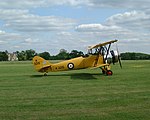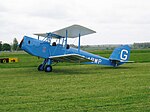|
Reach for the Sky
Reach for the Sky is a 1956 British biographical film about aviator Douglas Bader, based on the 1954 biography of the same name by Paul Brickhill. The film stars Kenneth More and was directed by Lewis Gilbert. It won the BAFTA Award for Best British Film of 1956. The film's composer John Addison was Bader's brother-in-law. PlotIn 1928, Douglas Bader joins the Royal Air Force (RAF) as a Flight Cadet. Despite a friendly reprimand from Air Vice-Marshal Halahan for his disregard for service discipline and flight rules, he successfully completes his training and is posted to No. 23 Squadron at RAF Kenley. In 1930, he is chosen to be among the pilots for an aerial exhibition. Later, although his flight commander has explicitly banned low level aerobatics (as two pilots have been killed trying just that), he is goaded into it by a disparaging remark by a civilian pilot. The wing tip of his bi-plane touches the ground during his flight and he crashes dramatically, and is clearly badly injured. Mr Joyce, surgeon at the Royal Berkshire Hospital, has to amputate both legs to save Bader's life. During his convalescence, he receives encouragement from Nurse Brace. Upon his discharge from the hospital, he sets out to master prosthetic legs. Out for a drive with two other RAF pals, they stop at a tearoom, and here he meets waitress Thelma Edwards. Once he can walk on his own, he asks her out. Despite his undiminished skills, he is refused flying duties simply because there are no regulations covering his situation. Offered a desk job instead, he leaves the RAF and works unhappily in an office. He and Thelma marry at a registry office on a wet afternoon. As World War II starts, Bader talks himself back into the RAF. He is soon given command of a squadron comprising mostly dispirited Canadians who had fought in France. Improving morale and brazenly circumventing normal channels to obtain badly needed equipment, he makes the squadron operational again. They fight effectively in the Battle of Britain. Bader is then put in charge of a new, larger formation of five squadrons. Later, he is posted to RAF Tangmere and promoted to wing commander. In 1941, Bader has to bail out over France. He is caught, escapes, and is recaptured. He then makes such a nuisance of himself to his jailers, he is repeatedly moved from one POW camp to another, finally ending up in Colditz Castle. He is liberated after four years of captivity. The war ends (much to Thelma's relief) before Bader can have "one last fling" in the Far East. On 15 September 1945, the fifth anniversary of the greatest day of the Battle of Britain, Bader, now a group captain, is given the honour of leading eleven other battle survivors and a total of 300 aircraft in a flypast over London. CastCredited
Uncredited
ProductionLewis Gilbert said Daniel Angel wanted to buy the rights for the book even without having read it, before it had been published, because he sensed it was going to be a best seller. Angel bought the film rights for £15,000 and showed the book to Lewis Gilbert while they were making The Sea Shall Not Have Them together. Gilbert and Vernon Harris started writing the script but Harris dropped out. Terence Rattigan turned down the job. H Bates started writing it and turned it down. William Alec Douglas tried then gave it up. Lewis Gilbert wrote the script in collaboration with Paul Brickhill who wrote the book.[4] Richard Burton was the first choice for the lead and he was considering it but he dropped out when he was offered the lead in Alexander the Great at what Gilbert describes as "three or four times the salary".[5] The second choice was Laurence Olivier who turned it down – Gilbert later admitted Olivier would have been miscast.[4] Kenneth More was cast instead at a fee of £25,000.[6] Producer Daniel Angel recalled:
More arranged to meet Bader to prepare for the role. They played a round of golf; much to More's surprise (as he was a good golfer), Bader beat him decisively.[7] Lewis Gilbert said Douglas Bader was difficult to deal with and did not help at all during filming:
To depict the various Royal Air Force bases realistically, principal filming took place in Surrey at RAF Kenley, and around the town of Caterham. The cricket match was filmed at nearby Whyteleafe recreation ground. Studio work was completed at Pinewood Studios. Available wartime combat aircraft including Hawker Hurricane and Supermarine Spitfire fighters were arranged to take on the aerial scenes. Angel later said that his favourite part of the film was when Bader was trying to learn how to walk again in hospital. "I've been in hospital myself, on and off since the war, and I'd seen a lot of that sort of thing," he later said. "It was a very touching performance from Dorothy Alison, who seemed to sum up so much in a few moments."[1] Alison received a BAFTA nomination for Best British Actress.[9] The film's composer John Addison was Bader's brother-in-law.[10] The book was also adapted for Australian radio in 1954. ReceptionThe film fared well with the public, being the most popular film in the UK for 1956. When the film was released in North America in 1957, the American release version was slightly altered with 12 minutes edited out. The Rank Organisation, the film's distributor, made a concerted effort to ensure the film was successful in America, sending Kenneth More over to do a press tour, and setting up Rank's own distribution arm in North America, but the public was not enthusiastic.[11][12] Because Bader had fallen out with Brickhill over the split of royalties from the book, he refused to attend the premiere, and only saw the film for the first time eleven years later, on television.[13] When the film was released, people associated Bader with the quiet and amiable personality of actor More. Bader recognised that the producers had deleted all those habits he displayed when on operations, particularly his prolific use of bad language. Bader once said, "[they] still think [I'm] the dashing chap Kenneth More was."[14] It won the BAFTA Award for Best British Film of 1956. Filmink later argued the film "became acknowledged as a classic, unfairly mocked by Gen-X critics who were forced to watch it on television too many times, and who forget that the film was made by people and for audiences who had been through that conflict, many of whom had seen people die, and could view it in proper context."[15] Aircraft
ReferencesNotes
In the scene where Bader is attempting to rejoin the RAF at the beginning of the war, Stephenson's name and rank may be seen on the door from which Sanderson emerges. Citations
Bibliography
External links |
|||||||||||||||||||||||||||||||||||||||||||||||||||||||||||||||||||||||||||||||||||||||||||||||||||||||||||||||||||||||||||||||||||||||









